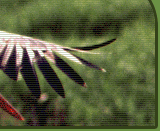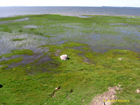 | | Coastal meadows at Mastalu | | bay Northern part | Experience of floodplain management in Estonian Western coast At the beginning of August, municipality partners of LIFE-Nature project “Restoration of Latvian Floodplains for EU priority species and habitats”, rural advisers, most active landowners and participant’s nature protection institutions made a two-day study trip to Matsalu National Park in Estonia within the framework of the above mentioned project. The Northern neighbors have unique experience in floodplain management. They were the first in the Baltic who begun to pay subsidies for grassland management, already in 1996.  | | Coastal meadows at Mastalu | | bay Northern part | Experience of floodplain management in Estonian Western coast At the beginning of August, municipality partners of LIFE-Nature project “Restoration of Latvian Floodplains for EU priority species and habitats”, rural advisers, most active landowners and participant’s nature protection institutions made a two-day study trip to Matsalu National Park in Estonia within the framework of the above mentioned project. The Northern neighbors have unique experience in floodplain management. They were the first in the Baltic who begun to pay subsidies for grassland management, already in 1996. Matsalu National Park is situated in the western part of Estonia. The nature reserve was established in 1957 mainly to protect nesting, moulting and migratory birds. In 1976 Matsalu was included in the list of wetlands of international importance under the Ramsar convention. There are 275 species of birds, 49 species of fish and 47 species of mammals registered in the area of the national park, also 772 species of vascular plants. Also the landscapes are unique and protected - floodplains, reedbed, coastal meadows, wooded meadows and islets. Historically, there are many similarities in the Latvian and Estonian agriculture and nature protection history. The significant part of the landscape has been created for many centuries, when farmers extensively managed the area. The most dramatic period of changes was in 20th century. Few countries in the world have undergone three periods of comprehensive land reform within the same century. In Estonia the sequence of changes has been the following: division of manorial estates into small farms in the 1920s, the collectivization of all farms in 1949, and finally the restitution of land to legitimate owners and privatization of state property starting in 1991. Previous experience suggests that the structural changes in agriculture require more resources and time than those in other sectors of the economy - approximately 20 years. Therefore, the period of agricultural adaptation requires more attention from the public, as well as the government. Developments in the Estonian agriculture have been influenced by changes in the economic environment, as well as contradictory attitudes and ideological value judgements. Contradictions in agricultural policy were clear already at the beginning of the 1930s, when the most respected analyst of rural policy at the time, Karl Liidak commented: "Rural life is progressing at both levels simultaneously: roots stay in the old soil while crowns reach towards fresh air". One of the main contradictions was the fact that for Estonian farmers of that time, farms were more than just commercial enterprises. As Liidak wrote, the connection of the farmer with his land and with the entire rural mode of life at that time was organic and spiritual rather than economic. Or, in modern terminology - it constituted his way of life and was more than merely profit-oriented. | 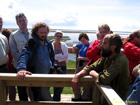
| | Ainârs Auniňđ and Aare Lepiks | | are discussingabout birds | | migrationm in Matsalu | After the restoration of independence in 1991, similar contradictions were revealed again. They affected the agricultural policy of the first years of independence, as well as the ideological basis of laws. The reform process, in which assets were restored to legitimate previous owners or privatized by new entrepreneurs, created conflicts between legal rights and economic principles. The technological capacities of former collective farms were designed for servicing large areas, 1200 to 1500 ha of arable land. The largest part of land use in Matsalu National Park nowadays is state owned, and smaller part is private property. A lot of the local farmers are renting agricultural lands for grass cutting or pasturing from state. In contrast with Latvia – it is permitted to buy the land for foreigners. The land is used for fishing, traditional pasturing and hay making, and in smaller proportions – also for forestry and hunting. Aare Lepik, the guide and a participant of several international nature protection projects is considering: “We would like to have Matsalu as a really wild and natural place, but we can’t forget that the most characteristic landscapes here are formed by people. Landscapes of this unique area can’t be protected for longer future without involving nature friendly management methods performed by the locals.” The largest changes in Matsalu happened in the 30s of 20th century, when the culmination of agricultural development in Estonia took place. Sometimes the hay was so necessary, that people gathered it directly from over flooded meadows, standing knee-high in water. Then the river Kasari and other smaller rivers were straightened and natural meanders were destroyed to minimize the effectiveness of floods every spring. The Riverbed of Kasari was also made deeper up to 3-4 m, which has made irreversible changes. Due to historical origin of Matsalu Bay and natural changes, reedbeds nowadays cover about 3000 ha around Matsalu Bay. This sure is one of the largest monolith reedbed areas in Europe. 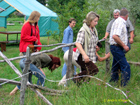 | | Searching for experience at | | Argo Hein farm | Argo Hein, 31, a man with agricultural education, today is one of the largest farmers in Matsalu National Park. He has about a hundred cows, the largest part from which is Hereford breed. They pasture important part of coastal meadow area, whereas the peripheral meadows are used for hey cutting, which is prepared in rolls of weight of 250 kg. Traditional hay gathering methods seems to be already a history here – there are only two hayracks made every year for showing it to tourists, displaying how people worked here earlier. This year the government of Estonia decided to give priorities for other sections of agriculture. That is why A.Hein and other farmers have smaller subsidies for management of natural grasslands as in Latvia at the same time. However, there is another National program in combination with Matsalu National Park support. Subsidies for the management of natural grasslands are not higher than 80 EUR per hectare. A.Hein says that it is no secret that it is possible to gain money and he is just happy about the economic management in the National park: “I don’t like to live in the city and I really love this open area and this style of life” | 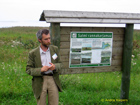
| | Alex Lotman, one of the | | founders of Estonian Fund | | for Nature, has presented Matsalu | | National Park and Estonain | | Agro Environmental policy | Alex Lotman, the manager of LIFE-Nature project in Matsalu National Park is sure: “Agro - Environmental payment system will be implemented in Estonia very soon. They will do this, because out of 1,1 millions ha of agricultural lands one fifth is natural grasslands and the same amount is also in NATURA 2000 territories, which is 16% of Estonian mainland.” Many examples of restored meadows, eco-tourism infrastructure, and hay making activities have aroused different discussions and reflections in the group of visiting Latvians. Coastal meadows, park meadows and floodplain meadows were for Nature visited, many stories about reed removal, cow breeding, bird and even sand toad habitat restoration were told. New knowledge was acquired; mutual experience on the situations of regional governments and among individual landowners was compared. Life-Nature project participants from Latvian Fund for Nature have gained valuable knowledge. Numerous cultural and historical values can be seen in Matsalu National Park. Here and there it was possible to enjoy true Estonian hospitality. At the end of the journey after we looked through EU common agricultural tendencies, a unifying thought appeared, that having chosen environment friendly management of grasslands on the territory of NATURA 2000 we have chosen the right direction that has good prospects. Additional information about agriculture and nature conservation in Estonia can be found on the web site of Estonian Agricultural Ministry or at Estonian Agricultural Registration and Information Centre web site. Andris Klepers, public awareness coordinator | 
